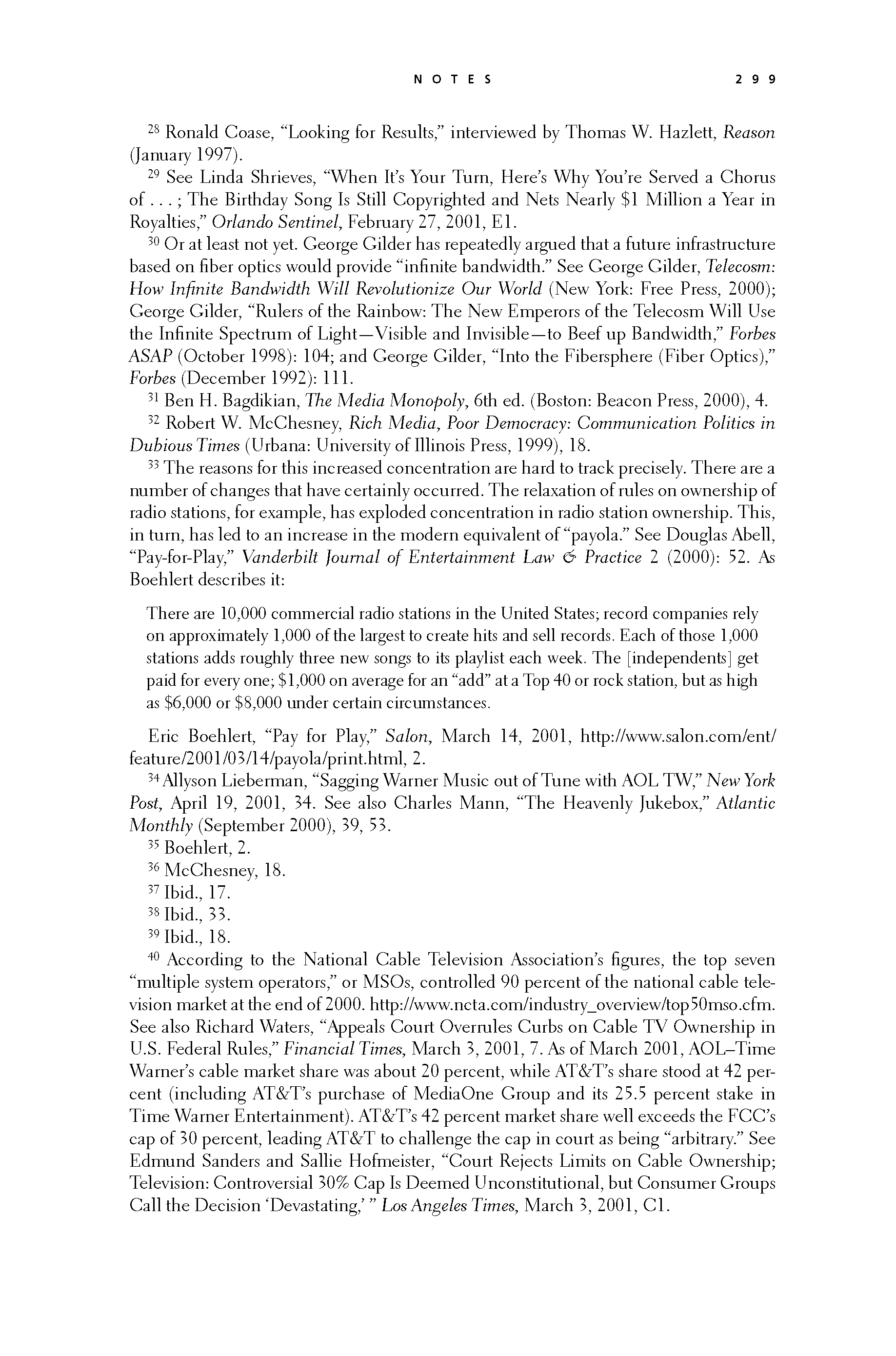 p298 _
-chap- _
toc-1 _
p299w _
toc-2 _
+chap+ _
p300
p298 _
-chap- _
toc-1 _
p299w _
toc-2 _
+chap+ _
p300
[7-28] Ronald Coase, "Looking for Results," interviewed by Thomas W. Hazlett, _Reason_
(January 1997).
[7-29] See Linda Shrieves, "When It's Your Turn, Here's Why You're Served a Chorus
of...; The Birthday Song Is Still Copyrighted and Nets Nearly $1 Million a Year in
Royalties," _Orlando_Sentinel,_ February 27, 2001, E1.
[7-30] Or at least not yet. George Gilder has repeatedly argued that a future infrastructure
based on fiber optics would provide "infinite bandwidth." See George Gilder, _Telecosm:_
_How_Infinite_Bandwidth_Will_Revolutionize_Our_World_ (New York: Free Press, 2000);
George Gilder, "Rulers of the Rainbow: The New Emperors of the Telecosm Will Use
the Infinite Spectrum of Light -- Visible and Invisible -- to Beef up Bandwidth," _Forbes_
_ASAP_ (October 1998): 104; and George Gilder, "Into the Fibersphere (Fiber Optics),"
_Forbes_ (December 1992): 111.
[7-31] Ben H. Bagdikian, _The_Media_Monopoly,_ 6th ed. (Boston: Beacon Press, 2000), 4.
[7-32] Robert W. McChesney, _Rich_Media,_Poor_Democracy:_Communication_Politics_in_
_Dubious_Times_ (Urbana: University of Illinois Press, 1999), 18.
[7-33] The reasons for this increased concentration are hard to track precisely. There are a
number of changes that have certainly occurred. The relaxation of rules on ownership of
radio stations, for example, has exploded concentration in radio station ownership. This,
in turn, has led to an increase in the modern equivalent of "payola." See Douglas Abell,
"Pay-for-Play," _Vanderbilt_Journal_of_Entertainment_Law_&_Practice_ 2 (2000): 52. As
Boehlert describes it:
____ There are 10,000 commercial radio stations in the United States; record companies rely
____ on approximately 1,000 of the largest to create hits and sell records. Each of those 1,000
____ stations adds roughly three new songs to its playlist each week. The [independents] get
____ paid for every one; $1,000 on average for an "add" at a Top 40 or rock station, but as high
____ as $6,000 or $8,000 under certain circumstances.
Eric Boehlert, "Pay for Play," _Salon,_ March 14, 2001, http://www.salon.com/ent/
feature/2001/03/14/payola/print.html, 2.
[7-34] Allyson Lieberman, "Sagging Warner Music out of Tune with AOL TW," _New_York_
_Post,_ April 19, 2001, 34. See also Charles Mann, "The Heavenly Jukebox," _Atlantic_
_Monthly_ (September 2000), 39, 53.
[7-35] Boehlert, 2.
[7-36] McChesney, 18.
[7-37] Ibid., 17.
[7-38] Ibid., 33.
[7-39] Ibid., 18.
[7-40] According to the National Cable Television Association's figures, the top seven
"multiple system operators," or MSOs, controlled 90 percent of the national cable tele-
vision market at the end of 2000. http://www.ncta.com/industry_overview/top50mso.cfm.
See also Richard Waters, "Appeals Court Overrules Curbs on Cable TV Ownership in
U.S. Federal Rules," _Financial_Times,_ March 3, 2001, 7. As of March 2001, AOL-Time
Warner's cable market share was about 20 percent, while AT&T's share stood at 42 per-
cent (including AT&T's purchase of MediaOne Group and its 25.5 percent stake in
Time Warner Entertainment). AT&T's 42 percent market share well exceeds the FCC's
cap of 30 percent, leading AT&T to challenge the cap in court as being "arbitrary." See
Edmund Sanders and Sallie Hofmeister, "Court Rejects Limits on Cable Ownership;
Television: Controversial 30% Cap Is Deemed Unconstitutional, but Consumer Groups
Call the Decision 'Devastating,'" _Los_Angeles_Times,_ March 3, 2001, C1.
[[299]]
p298 _
-chap- _
toc-1 _
p299w _
toc-2 _
+chap+ _
p300